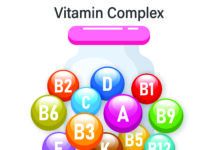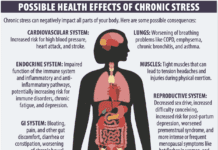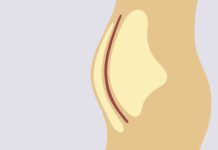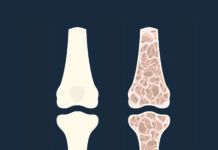Age-related macular degeneration (AMD) is the leading cause of severe vision loss in Americans over age 65. As AMD progresses, it permanently damages the portion of the eye’s light-sensing retina (the macula) that provides sharp central vision.
Epidemiological studies from Tufts scientists and others have observed links between a healthy diet and greater risk for AMD. Now, researchers at Tufts have uncovered one of the dietary factors that could help drive the connection between diet and AMD. Mice fed a low-glycemic diet—relatively rich in slowly digested whole grains—showed fewer changes in the retina characteristic of AMD, compared with mice fed a high-glycemic diet containing rapidly digested carbohydrates. In a surprising and exciting finding, switching the mice from a high- to a low-glycemic diet appeared to stop retinal damage.
Although mice lack a macula, their retinas do develop damage very similar to that of AMD, and the results of the experiments were consistent with previous observational studies linking diet and risk for AMD. This gives scientists more confidence that they are on the right track to developing a dietary intervention for AMD in humans, says Sheldon Rowan, PhD, a scientist at the Tufts HNRCA Nutrition and Vision Research Laboratory. “Along with the demonstrated health benefits of a lower glycemic diet on metabolic disease and cardiovascular health, our research suggests that lower glycemic diets may also lower the risk of AMD.”
The Gut-Retina Axis: As detailed in recent publications in PNAS and Gut Microbes, research by Rowan and lab director Allen Taylor, PhD, point to gut microorganisms as the possible missing link between what you eat and risk for AMD. The Tufts scientists call it the “gut-retina axis.” The human gut microbiome is the diverse assemblage of bacteria that live in the intestines. The bacteria, research suggests, can have both helpful and harmful influences on health—depending, in part, on the glycemic index of your diet.
Rowan and Taylor speculated that changes in the gut bacteria associated with high-glycemic diets may be responsible for changes in vision. Mice were fed either a high-glycemic or low-glycemic diet. The diets differed in only one respect: the type of carbohydrates. Starchy, refined carbs can cause spikes in blood sugar; more unrefined carbs, like those from whole grains, trigger a more gradual rise.
When the mice reached “old age” at 24 months, the ones fed the high-glycemic diet had developed retinal changes seen in AMD, including shrinkage and loss of light-sensing photoreceptors. Then, when these mice were switched to a lower-glycemic diet, the damage stopped or reversed.
Retina Protectors: The mouse experiments also revealed a possible mechanism for how refined carbohydrates may affect vision. The particular mix of bacteria in the mouse gut was different in mice on the low- versus the high-glycemic diet. These microorganisms then, in turn, appeared to influence the release of chemical substances known as metabolites.
Some metabolites appear to protect the retina from damage. In response to a high-glycemic diet, the gut bacteria in those mice may produce lower levels of protective metabolites, or somehow increase the production of other metabolites that can harm the retina.
These findings add up to a potential explanation for why low-quality diets are associated with greater risk of AMD—and confirm previous studies showing associations between higher-quality diets and lower risk of AMD.
What You Can Do Now: It’s too soon to recommend a low-glycemic diet to prevent AMD. More studies in mice and, eventually, trials in people are planned. But nutrition may help to slow the progress of early AMD. Observational studies show that a healthy overall dietary pattern is associated with less chance of vision loss. Substituting unrefined in your diet for refined carbohydrates can be a good start.
In some cases, taking a special dietary supplement can be helpful. Two clinical trials by the National Eye Institute called AREDS1 and AREDS2 showed that taking a special formulation of vitamins and other nutrients helps prevent the early “dry” form of AMD from progressing to the more damaging “wet” type, in which, abnormal, leaky blood vessels invade the retina. The American Academy of Ophthalmology recommends taking the AREDS supplement to reduce the risk of early AMD progressing to the advanced stage of the disease.
-To prevent age-related loss of vision, the American Academy of Ophthalmology recommends a baseline comprehensive eye exam at age 40.
-At age 65, as your risk for AMD increases, schedule an exam with an ophthalmologist every 1 to 2 years.
-If diagnosed with the early, less-severe “dry” form of AMD, talk to your ophthalmologist about taking a specially formulated vitamin supplement, based on the findings of clinical trials, that can slow progression to the later, more damaging “wet” form of AMD.
-Regularly consume a healthy overall dietary pattern, substituting unrefined for refined grain products.
























What defines a low glycemic diet:? Exactly what foods are low glycemic?
I have amd in both eyes; the left eye is worse. I also take Areds 2. I am frantic about saving the sight I have and want to know what I need to eat to strengthen the macula. Your advice is appreciated.
Ideally, you should check with your doctor, ophthalmologist or possibly a dietitian regarding what comprises a low glycemic diet. As this article defines it, though, it consists of whole grains for the carbohydrate portion of your diet.
I believe your comments about the AREDS formula are incorrect.
Check your statements. I believe you will find that AREDS has no effect on progression of early macular degeneration.
No mention was made of lutein, and other valuable nutrients which may prevent or slow diseases of the eye
As an MD, I do not think the public is helped by mice, rat, and otheranimal studies as the findings are not always confirmed in humans. The public has had a growing mistrust of nutritional advice, and science in general. If the findings of this study are not confirmed in humans, then what?
Dr. Halle, this article seems to define a low-glycemic diet as one rich in complex (vs. simple or processed) carbohydrates. Such carbohydrates have been associated in humans with beneficial effects so even if it is eventually found that the mice results do not translate to humans, I don’t see a problem with following a low-glycemic diet since it appears to be healthful in general.
need to define Areds1 and Areds2.
Digby – AREDS 2 contains Lutein.
I can no longer drive. Huge life altering outcome. I’ll try most anything as long as it is not harmful.